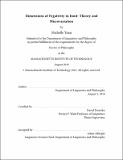| dc.contributor.advisor | David Pesetsky. | en_US |
| dc.contributor.author | Yuan, Michelle,Ph. D.Massachusetts Institute of Technology. | en_US |
| dc.contributor.other | Massachusetts Institute of Technology. Department of Linguistics and Philosophy. | en_US |
| dc.date.accessioned | 2019-09-11T21:55:25Z | |
| dc.date.available | 2019-09-11T21:55:25Z | |
| dc.date.copyright | 2018 | en_US |
| dc.date.issued | 2018 | en_US |
| dc.identifier.uri | https://hdl.handle.net/1721.1/122054 | |
| dc.description | This electronic version was submitted by the student author. The certified thesis is available in the Institute Archives and Special Collections. | en_US |
| dc.description | Thesis: Ph. D. in Linguistics, Massachusetts Institute of Technology, Department of Linguistics and Philosophy, 2018 | en_US |
| dc.description | Cataloged from student-submitted PDF version of thesis. | en_US |
| dc.description | Includes bibliographical references (pages 251-274). | en_US |
| dc.description.abstract | This thesis investigates microvariation in the ergative system of the Inuit dialect continuum, as a window into the theoretical status of ergative alignment, argument licensing, and Agree. The empirical focus of this thesis is on the Inuit varieties in which the canonical erg-abs ergative construction has been observed to be relatively weak compared to other varieties, arising in an unusual case alignment that has properties of both ergative and accusative systems (e.g. Johns, 2001, 2006; Carrier, 2017). Consequently, from a typological standpoint, the existence of such variation oers a unique testing ground for examining these grammatical phenomena. While most previous literature on this weaker pattern has focused on the widening distribution of the abs-mod antipassive construction, I present novel evidence pointing towards microvariation in the syntax of the ergative construction itself. | en_US |
| dc.description.abstract | The central proposal of this thesis is that the status of ergativity within a given Inuit variety is directly attributable to the underlying status of its object agreement morphology, and that this is the source of variation in case alignment properties across the Inuit dialect continuum. This correlation is revealed by documenting and analyzing several previously unnoticed properties of Inuktitut, the group of Inuit dialects spoken in Nunavut, Canada. In particular, the object-referencing morphemes in Inuktitut pattern like pronominal doubled clitics, diverging from canonically ergative Inuit varieties (e.g. Kalaallisut, spoken in Greenland), whose object-referencing morphemes behave like exponents of true -agreement. I present a novel analysis of ergativity across Inuit that recasts this - agreement vs. clitic doubling distinction as variation in the syntactic nature of the structurally high abs object co-occurring with the erg subject. | en_US |
| dc.description.abstract | Specially, I argue that the modality of erg case assignment holds constant across all dialects: erg case is uniformly a dependent case (Marantz, 1991; Baker, 2015), assigned to a nominal in the presence of a second, structurally local nominal element (its case competitor). However, the distribution of erg case is simultaneously constrained by the nature of its local case competitor -- which is a full abs DP in robustly ergative varieties such as Kalaallisut, but a pronominal D0 element in more weakly ergative varieties such as Inuktitut. Variation in the status of ergativity across Inuit is therefore solely determined by the properties of the transitive object, while the properties of the transitive (erg-marked) subject remain constant. I then relate the theoretical underpinnings of this proposal to two other major properties of Inuktitut grammar. First, I argue that clitic doubling is derived by two interacting steps -- | en_US |
| dc.description.abstract | syntactic movement of a D0-element, followed by postsyntactic Merger--and demonstrate that the pronunciation of movement chains is regulated by Merger. Crucially, this same level of interaction can be seen to underlie certain recalcitrant aspects of noun incorporation in Inuktitut, in turn motivating a postsyntactic analysis of Inuktitut noun incorporation (cf. Bok-Bennema and Groos, 1988). Second, I argue that clitic doubling is triggered by -Agree, which in Inuktitut is able to target DPs but not PPs; encountering a PP leads to failed Agree (Bobaljik, 2008; Preminger, 2011, 2014). This is evidenced by hitherto unnoticed interactions between -Agree and anaphoric objects, which are argued to bear lexical mod case as an Anaphor Agreement Eect, as well as parallel interactions between -Agree and antipassive objects,which bear structural mod Case (cf. Bok-Bennema, 1991; Spreng, 2012). | en_US |
| dc.description.abstract | More broadly, this thesis oers a case study on using microvariation as a methodology for investigating syntactic theory, and vice versa, by treating the Inuit varieties under discussion as minimally-diering points along an otherwise gradient system. | en_US |
| dc.description.statementofresponsibility | by Michelle Yuan. | en_US |
| dc.format.extent | 274 pages | en_US |
| dc.language.iso | eng | en_US |
| dc.publisher | Massachusetts Institute of Technology | en_US |
| dc.rights | MIT theses are protected by copyright. They may be viewed, downloaded, or printed from this source but further reproduction or distribution in any format is prohibited without written permission. | en_US |
| dc.rights.uri | http://dspace.mit.edu/handle/1721.1/7582 | en_US |
| dc.subject | Linguistics and Philosophy. | en_US |
| dc.title | Dimensions of ergativity in Inuit : theory and microvariation | en_US |
| dc.type | Thesis | en_US |
| dc.description.degree | Ph. D. in Linguistics | en_US |
| dc.contributor.department | Massachusetts Institute of Technology. Department of Linguistics and Philosophy | en_US |
| dc.identifier.oclc | 1108654617 | en_US |
| dc.description.collection | Ph.D.inLinguistics Massachusetts Institute of Technology, Department of Linguistics and Philosophy | en_US |
| dspace.imported | 2019-09-11T21:55:22Z | en_US |
| mit.thesis.degree | Doctoral | en_US |
| mit.thesis.department | Ling | en_US |
